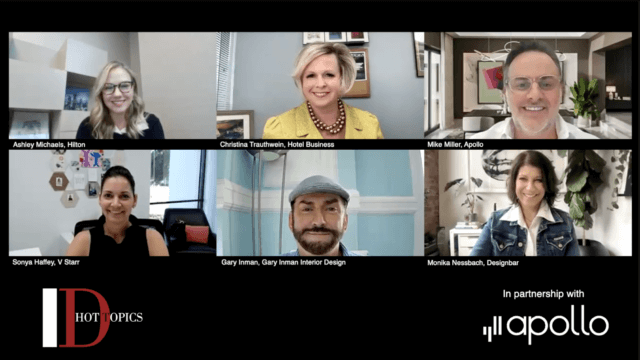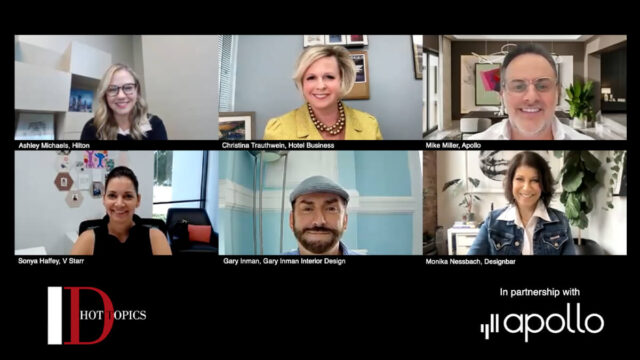Art—modern, traditional, digital. That’s the beauty of art, it can be whatever the guest, or designer, wants it to be. In the hospitality space, art has the ability to tell a hotel’s story—to communicate its surrounding culture, feature local flair, and of course, to inspire.
In the InspireDesign Hot Topics session, “The Art of the Matter: Emerging trends that evoke and inspire,” in partnership with Apollo Art, design leaders discussed the latest trends in the art world and how designers can take advantage of the opportunities that abound.
Moderated by Christina Trauthwein, VP, content & partnerships, InspireDesign/Hotel Business, the panel included Michael Miller, creative vision officer, Apollo Art; Sonya Haffey, principal, V Starr; Monika Nessbach, CEO, Designbar; Gary Inman, president/principal designer, Gary Inman Interior Design and assistant professor, interior design, High Point University; and Ashley Michaels, senior manager, Hilton.
Miller kicked it off with some background on Apollo, explaining that what started as a pet project for him has taken over his life in the past five years.
Apollo seeks to revolutionize the way the art world intersects with the real world, allowing access to art that has the power to improve people’s lives. Using technology to break down the barriers to engagement, Apollo’s patented software solution helps bring together art and design together, with curation, connection and community.
“This is definitely a conversation I love to have and I find myself having these conversations multiple times on a daily basis because I think art is so impactful and empowering in our lives,” Miller said. “With today’s challenges, I think art is very inclusive and brings people together. I wanted an easy way to learn about art, display works for people to learn, for artists to be able to share their works with anyone across the globe, and for Apollo to be that platform that people can go to to learn and promote the creator community.”
Inman noted that as an educator, he believes people are fundamentally intimidated by art, but this can be easily remedied with the right education.
“I have some clients who are incredibly sophisticated but they’re really uncomfortable when it comes to art and I think education is critical,” Inman said. “We need to start educating everyone in America to have some understanding of art and not be intimidated. Embrace it, love it and participate with it.”
Post-pandemic, artists have found creative ways to showcase their artwork and process. Although sometimes unconventional, this can art more approachable.
“Art has become way more accessible than it used to be,” Nessbach said. “If we look at social media, it has given us access to artists and art expressions that we haven’t seen before. There are so many ways now to acquire art, to get original art and also people are more interested in seeing artists through the media.”
Media has surely equipped artists with new platforms, which, in turn, has given many exposure that they may not have otherwise. In fact, many major cities have embraced local artists discovered on social media.
“When you want to develop a property and you’re an owner, you’re required to have some type of public art or park or some kind of space you create. There’s a lot of graffiti on empty walls that makes art attainable…It makes people believe that it’s part of that education and if you can feel it, you can also be a part of that,” Haffey said.
Michaels weighed in on the renovation side, noting that many materials and art of up for negotiation—what should a hotel keep and what should it trash? With art oftentimes a lower line item in budgets, she explained designers should advocate for art and get creative with how they incorporate it.
“I think there’s an argument to be made of, ‘why are we always trashing that?’ We could be searching for someone through social media who is local or has a story to tell that could be incorporated into a more additive approach to the pieces and get a second life out of pieces,” Michaels said. “There aren’t any rules. Why is fine art inaccessible? I think it’s because the fine art community has created that language and I don’t think we have to live by that anymore. Art is only based on who’s appreciating it. My approach to art, in all avenues, is if you have a reaction to it good, bad or indifferent, it’s accessible because you have a feeling.”
For more insights on this Hot Topics session, make sure to check out the winter edition of InspireDesign.




